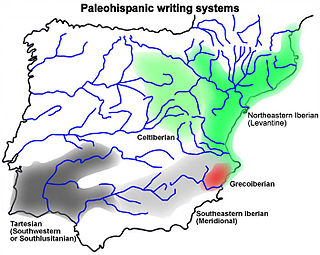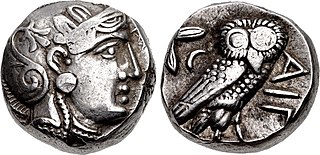
The Iberians were an ancient people settled in the eastern and southern coasts of the Iberian Peninsula, at least from the 6th century BCE. They are described in Greek and Roman sources. Roman sources also use the term Hispani to refer to the Iberians.

The Celtiberians were a group of Celts and Celticized peoples inhabiting an area in the central-northeastern Iberian Peninsula during the final centuries BC. They were explicitly mentioned as being Celts by several classic authors. These tribes spoke the Celtiberian language and wrote it by adapting the Iberian alphabet, in the form of the Celtiberian script. The numerous inscriptions that have been discovered, some of them extensive, have enabled scholars to classify the Celtiberian language as a Celtic language, one of the Hispano-Celtic languages that were spoken in pre-Roman and early Roman Iberia. Archaeologically, many elements link Celtiberians with Celts in Central Europe, but also show large differences with both the Hallstatt culture and La Tène culture.

The Vaccaei or Vaccei were a pre-Roman Celtic people of Spain, who inhabited the sedimentary plains of the central Duero valley, in the Meseta Central of northern Hispania. Their capital was Intercatia in Paredes de Nava.

The Oretani or Oretanii were a pre-Roman ancient Iberian people of the Iberian Peninsula, that lived in northeastern Andalusia, in the upper Baetis (Guadalquivir) river valley, eastern Marianus Mons, and the southern area of present-day La Mancha.

Cheste is a municipality in the comarca of Hoya de Buñol in the Valencian Community, Spain, located 26 km from the capital Valencia.

Sagunto is a municipality of Spain, located in the province of Valencia, Valencian Community. It belongs to the modern fertile comarca of Camp de Morvedre. It is located approximately 30 km (19 mi) north of the city of Valencia, close to the Costa del Azahar on the Mediterranean Sea.

The southeastern Iberian script, also known as Meridional Iberian, was one of the means of written expression for the Iberian language, which was primarily written in the northeastern Iberian script and, to a lesser extent, by the Greco-Iberian alphabet. In understanding the relationship between the northeastern and southeastern Iberian scripts, some note that they are two distinct scripts with different values assigned to the same signs. However, they share a common origin, and the most widely accepted hypothesis is that the northeastern Iberian script was derived from the southeastern Iberian script.
The economy of Hispania, or Roman Iberia, experienced a strong revolution during and after the conquest of the peninsular territory by Rome, in such a way that, from an unknown but promising land, it came to be one of the most valuable acquisitions of both the Republic and Empire and a basic pillar that sustained the rise of Rome.

Hacksilver consists of fragments of cut and bent silver items that were used as bullion or as currency by weight during the Middle Ages.

The Olcades were an ancient stock-raising pre-Roman people from Hispania, who lived to the west of the Turboletae in the southeastern fringe of the Iberian system mountains.

Martín Almagro Gorbea is a Spanish prehistorian.

The Cordoba Treasure, or Tesoro de Córdoba in Spanish, is the name of a major Iron Age silver hoard found on the outskirts of the city of Córdoba, Spain in 1915. The entire treasure was purchased by the British Museum in 1932, where it has been on public display ever since.
Carthaginian or Punic currency refers to the coins of ancient Carthage, a Phoenician city-state located near present-day Tunis, Tunisia. Between the late fifth century BC and its destruction in 146 BC, Carthage produced a wide range of coinage in gold, electrum, silver, billon, and bronze. The base denomination was the shekel, probably pronounced in Punic. Only a minority of Carthaginian coinage was produced or used in North Africa. Instead, the majority derive from Carthage's holdings in Sardinia and western Sicily.

The history of ancient Iberian coinage begins as early as the fifth century BC, but widespread minting and circulation in the Iberian peninsula did not begin until late in the third century, during the Second Punic War. Civic coinages - emissions made by individual cities at their own volition - continued under the first two and a half centuries of Roman control until ending in the mid-first century AD. Some non-civic coins were minted on behalf of Roman emperors during this period and continued to be minted after the cessation of the civic coinages. After the cessation of the civic coinages, these Imperial coins were the only coins minted in Iberia until the coins of the Suebi and Visigoths.

The Cisjordan corpus of Phoenician Iron Age hacksilber (hacksilver), dated between 1200 and 586 BC, is the largest identified collection of pre-coinage silver in the ancient Near East. The corpus was identified by Christine Marie Thompson in 2003. The corpus is composed of 34 silver hoards found at 15 sites in ancient southern Phoenicia or modern Israel and Israeli-occupied territories, this area is termed "Cisjordan". Significant hoards have been found at Tel Dor, Eshtemoa, Tell Keisan, Ein Hofez, and Akko. The other hoards were found at Megiddo, Bet Shean, Shechem, Shiloh, Gezer, Tel Miqne-Ekron, Ashkelon, Ajjul, Ein Gedi, and Arad.
Pere Pau Ripollès Alegre is a Spanish archaeologist and numismatist.

The Kabul hoard, also called the Chaman Hazouri, Chaman Hazouri or Tchamani-i Hazouri hoard, is a coin hoard discovered in the vicinity of Kabul, Afghanistan in 1933. The collection contained numerous Achaemenid coins as well as many Greek coins from the 5th and 4th centuries BCE. Approximately one thousand coins were counted in the hoard. The deposit of the hoard is dated to approximately 380 BCE, as this is the probable date of the least ancient datable coin found in the hoard.

Mercenary life is recorded as a custom of Iron Age Spain, particularly in the central area of the Iberian Peninsula. Departing from the native tribe and applying to serve in others was a way for economically disadvantaged youth to escape poverty and find an opportunity to use their fighting skills. Starting from 5th century BC, mercenary life would become a true social phenomenon in Hispania, with great numbers of fighters from distant lands coming to join the armies of Carthage, Rome, Sicily and even Greece, as well as other Hispanic peoples.

Suzanne Frey-Kupper is a classical archaeologist and numismatist from Switzerland, who is Professor of Classics and Ancient History at the University of Warwick. She specialises in the study of Greek, Roman and Punic coinage, in particular examining their role in historical processes and as social agents.














